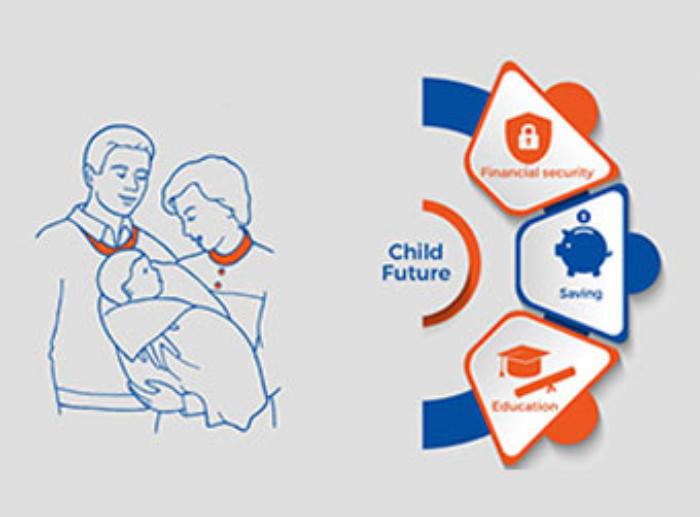Child Plans Myths vs Reality: Explaining the Facts
Blog Title
386 |
3/20/25 8:30 AM |
Parents always place the financial protection of their children at the top of their priority list. Each parent wants the best educational opportunities for their child. At the same time, parents also have to manage funds for their child’s medical care and other unexpected emergencies. This is why many parents invest in a life insurance plan for their children.
Child insurance plans solve the need for future stability through a combination of financial returns and life coverage benefits, which safeguard both present and future financial needs.
However, the prevailing myths about such plans can cause parents to miss out on some their actual advantages. Moreover, some parents may avoid child insurance altogether due to their incorrect assumptions on the costs, flexibility, and coverage of such plans.
Common Myths vs. Reality About Child Insurance Plans
Myth 1: Child Insurance Plans are Only for Education Expenses
The primary goal of buying a child insurance plan is usually to fund a child's educational expenses. However, child insurance policies can have numerous other benefits as well.
Child insurance plans can provide financial support during medical crises, offer additional funds for extracurricular activities, and also help you pay for day-to-day expenses.
The National Sample Survey Office (NSSO) ran a study that revealed that Indian higher education expenses rose by 175% from 2008-2014, and this price has only been rising since then. Rising education costs become manageable with the help of child insurance plans while also enabling parents to spend these funds on fundamental activities such as skill-based training and overseas study opportunities etc.
Myth 2: Child Plans are Too Expensive
Numerous parents perceive child insurance plans as financially out of reach because they think these policies are too expensive. However, Insurers provide multiple child insurance plans where the premium amount is adjustable. You can flexibly modify your premium amount and ensure that it matches your personal financial strength. This way, you can comfortably pay for a child insurance plan without being burdened by the premiums.
Say you invest ₹2,000 each month in a Unit Linked Insurance Plan (ULIP) from the day of your child's birth. These funds will substantially grow in value over the course of the next 18 years. The investment start date directly impacts the long-term budget that you need to allocate for a child insurance plan.
Additionally, many investors are unaware that ULIP taxation regulations allow for tax-free investments in certain circumstances, making them an appealing alternative for long-term financial planning.
Myth 3: The Child is the Policyholder
Another common myth is that the policyholder is the child themself. The reality, however, is quite different. When you purchase a child plan, the parent becomes the insurance policyholder, whereas the child takes the role of the policy beneficiary.
A premium waiver rider is typically available in most child insurance plans to ensure the policy’s continued existence even when the policyholder (parent) passes away. The premium waiver rider is usually an optional addon, but it is a must buy if you want to protect your child’s financial future even when you’re gone.
Myth 4: Child Plans Only Offer Life Insurance
Child insurance plans are usually savings insurance products, meaning that you not only get the benefit of life cover but also receive returns based on your invested premium. The two main types of child insurance plans available in the market are:
- Guaranteed Child Insurance Plans: They provide guaranteed maturity benefits through relatively low-risk policies.
- Unit Linked Insurance Plans: These allocate investments between equity and debt funds, providing potential growth opportunities.
Historically, equity-linked ULIPs have generated annual returns of 10-12%, making them competitive with other savings instruments. However, returns are market-dependent and not guaranteed.
Myth 5: You Can’t Withdraw Funds Before Maturity
This is another major misconception regarding child insurance policies. Many service providers allow partial withdrawal after a designated waiting period. This helps parents get access to necessary educational fees, healthcare payments and training program funds.
Unit-linked child insurance plans usually allow for partial withdrawals of up to 20% of the accumulated fund value after the policy completes its fifth year. These plans offer financial support through flexible withdrawal options, making funds accessible regardless of the policy term.
Myth 6: Insurance Payouts are Taxable
A lot of parents fear that the maturity returns from child insurance plans will be heavily taxed. Insurance death claims, along with maturity benefits, receive tax exemption under Section 10(10D) of the Income Tax Act, 1961. Note that this benefit is only available if the premium paid stays below 10% of the coverage amount. In the case of ULIPs, the annual premium should not exceed ₹2.5 lakhs.
The premiums paid for insurance plans are also eligible for tax deductions under Section 80C. You can get a maximum deduction of up to ₹1.5 lakh annually. Thus, child insurance plans serve as a tax-advantageous savings option for the future.
Myth 7: Child Insurance Plans Don’t Offer Good Returns
Reality shows that child insurance plan returns depend on the type of plan a person selects. Traditional child insurance plans based on endowments provide steady, low risk returns that are often guaranteed. On the other hand, ULIPs provide market-linked returns that have a high growth potential.
A child insurance plan that focuses on equity-linked funds can offer returns that combat inflation successfully. However, equity-linked plans also come with higher potential risk. So, if you are risk averse but still desire decent returns for your child’s future, consider getting a guaranteed income/returns plan instead.
Conclusion
Child insurance plans offer more than just basic life cover. They not only provide funds for educational expenses but also ensure comprehensive financial protection for a child's future.
Parents should choose a child insurance plan by evaluating their financial goals and selecting a policy that aligns with their long-term aspirations. By making informed decisions and overcoming misconceptions about child insurance, parents can enhance their child's financial security for the years ahead.









